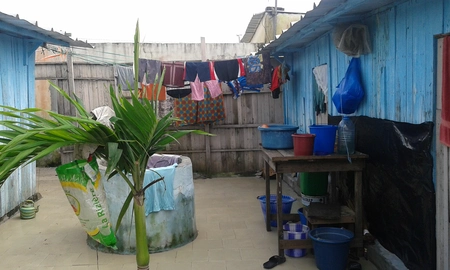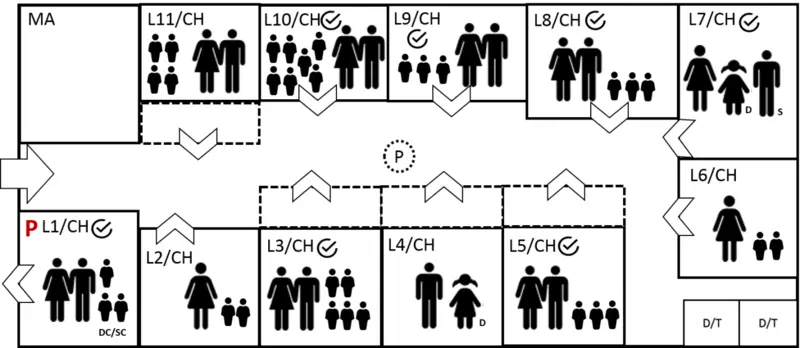Dense and tense: High population density and low-quality housing in Abidjan
September 15, 2020.
From London to Lagos, the Corona pandemic illustrates that high population densities coupled with insufficient social security and poor-quality housing increase not only infection rates but also vulnerability to mental stress. The pandemic shifted the focus to favelas, townships, or slums, where residents have been unable to observe physical distancing.
Population densities indicate economic inequalities
Unequal population densities and their relationship with living conditions in cities are not random. They are often the result of city administrations’ policies that focus on other priorities. The popular narrative continues to reason that dense quarters in African cities are a result of rural to urban migration and a short supply of formal, good-quality housing. Our findings from Abidjan in Côte d'Ivoire, however, underline the relevance of urban policy and private investors, as well as their impact on housing markets for the poor. Population densities in different parts of Abidjan, a West African city of five million inhabitants, range between ca. 4,900 to 26,800 inhabitants per km2. These numbers hint at economic stratification. While most houses in the well-off and middle-class quarters are multi-storey buildings such as villas or apartment blocks, the dominant housing type in precarious quarters, where population densities are highest, are low-rise buildings, so-called courtyard houses. In practice, the everyday spaces of residents are even denser as people live and work at ground level.
Ethnographic research in an unplanned settlement
We carried out an ethnographic census in Adjahui-Coubé, an unplanned settlement on a central peninsula in Port Bouët Municipal District of Abidjan, in which we collected data on 52 courtyard houses and their residents to estimate current population numbers and identify typical housing conditions. Most households live in a rented single, windowless room of 9 to 10m2, constructed from wooden planks, without access to electricity or drinking water facilities in the house. The schematic of a courtyard house (see illustration below) shows a classical layout that includes a shop. It is home to 53 people who share a ground plot of ca. 200m2. The courtyard houses have been built wall-to-wall to one another, with a maze of paths and sand roads connecting them.
Are courtyard houses part of the housing solution?
People reach their homes, as well as basic sanitation facilities by walking through the courtyard. Such open spaces are shared for leisure, work, household activities and childcare. For many decades, these yards have shaped everyday life and social interactions in Abidjan. Perhaps this explains why courtyard houses are so popular among Abidjanais. We found that family courtyards and a higher share of owner-occupiers characterize older quarters, whereas rental housing dominates the younger unplanned settlements, such as Adjahui-Coubé. Here, informal real estate agencies facilitate contracts between small-scale private investors and their tenants.
Successive Ivorian governments and city administrations have never favored courtyard houses. Rather, they have perceived them as a hindrance to their goal of achieving urban modernity. Many such quarters have experienced demolitions, as well as forceful evic-tions after the political crisis in Côte d'Ivoire in 2011. Ironically, authorities justify evictions with the excuse that they are carried out to protect vulnerable populations against hazards and pandemics.The layout of courtyard houses, however, is not the problem. Instead, such houses are part of the solution as they satisfy the high demand for low-cost housing. Though population densities are high, the tenants of these affordable small housing units do enjoy the additional airy semi-public space of the yard. Where the government tolerated unplanned settlements, house owners and tenants improved the buildings over time, irrespective of absence of legal land titles. Housing quality became better, with stone buildings and windows for ventilation. In older quarters, electricity and tap water in the yard became normal amenities.
Reasons for intra-urban migration
Although housing quality in Adjahui-Coubé was found to be more precarious than in the older quarters of Abidjan, the settlement has attracted more than 60,000 new inhabitants since 2011. Evictions or demolitions, sky-rocketing security deposits and costly rental apartments in the regular city pushed many low-income individuals and families to the unplanned settlement. In some cases, former owner-occupiers became tenants. Interestingly, almost all the households had already lived in Abidjan and other cities before. We also observed some newly built courtyard houses located in planned quarters. The need to close the local rent gap, however, resulted in the houses having layouts that comprise 10m2 self-contained housing units and yards that function only as tight corridors. One can say that by prioritizing quick amortization of investment over housing quality, investors triggered densification in practice.
This article is from ZEFnews 41. To read the whole issue see https://www.zef.de/fileadmin/user_upload/ZEFnews_No_41_Webversion.pdf




